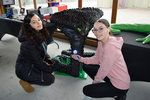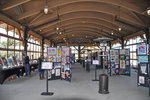 Narrowsburg
NarrowsburgLight Rain Fog/Mist, 43°
Wind: 8.1 mph
REGION — “Art is healing me.”
Those are “four of the words I remember most from almost 35 years of teaching in Philadelphia city schools,” Wayne County Arts …
Stay informed about your community and support local independent journalism.
Subscribe to The River Reporter today. click here
This item is available in full to subscribers.
Please log in to continueNeed an account?
|



Beth and Scott Beiko have brought music and dance to countless children since 1993, leading school assemblies, camp and library concerts and interactive workshops.
The arts that the Beikos teach bring children a host of different benefits. They can deliver information in ways kids can more easily understand, discussing kindness, say, or science.
Music can help children express themselves and their emotions. “Happiness can’t be understated, along with all the other emotions that children, I think, should be open to,” says Scott. Children have the opportunities to explore emotion through music and theater that they can’t easily access through other means.
Music can also engage childrens’ minds in ways that other subjects can’t. Scott teaches songwriting workshops with children, a practice that uses English for the lyrics, math for the music, and combines both of them together with social and emotional collaboration.
When the Beikos walk into a building where they’ve taught workshops before, the children they’ve taught scream their names, says Scott; a child’s relationship with them is based on the same mutual respect for each other’s ideas that a child has with their teacher.
REGION — “Art is healing me.”
Those are “four of the words I remember most from almost 35 years of teaching in Philadelphia city schools,” Wayne County Arts Alliance board member Debby Pollak wrote in an email.
The speaker was an eighth-grade girl, just back in class after being suspended for getting into a fight.
“It spoke to the crucial nature of art in education,” Pollak said.
The importance of the arts
“Too often the arts are given a secondary or minimal role in schools,” Eric Baylin, a poet and a visual artist, wrote, “but truly what would our lives be, what would the world be, without song and dance and pictures and poetry?”
The arts’ presence in school buildings has declined over that time, said Scott Beiko, a creative arts workshop leader. He attributed this to two causes. The ability for parents to raise money to supplement arts funding took a hit in the 2008 recession and has not since recovered, he said, and schools have faced pressure from businesses to prioritize the STEM fields, seeking a workforce at the expense of the arts.
“The arts are looked upon as extras, which I don’t believe they are,” Beiko said.
From galleries to theatres to music, the arts are part of the lifeblood of the area. But for kids, there are barriers too.
No transportation. Weather. Poverty. The kids are needed at home. All this means that classes in the community can struggle to get enough kids to sign on, which jeopardizes funding.
Schools could offer an answer. But that’s complicated.
The pandemic was an earthquake for education.
Management consultants McKinsey found that “the impact of the pandemic on K-12 student learning was significant, leaving students on average five months behind in mathematics and four months behind in reading by the end of the school year.” High schoolers were more likely to drop out, and seniors, especially those from low-income families, were less likely to go on to postsecondary education.
“The pandemic put a huge burden on all education systems,” said Lori Orestano-James, president of the New York State Alliance for Arts Education, a retired teacher and administrator and the president of the Monticello School Board. But the arts were particularly affected.
Consider remote learning. You can do visual art at home if you have the materials. But band? Theatre? Dance? “Those cannot be done in isolation,” Orestano-James said.
School is now in-person, but kids are dealing with grief, anxiety and depression. Maybe fear. Sometimes that comes out as sorrow, often as aggression. Emergency departments nationwide reported a 31-percent spike in admissions for suspected suicide attempts by teens.
The arts can ease the pain. “The arts tell stories of what’s going on, but also give a respite. They bring people together,” Orestano-James said.
She recalled the musicians performing on balconies during lockdown. “What a difference that made in people’s lives… we learned what art means.”
“Research has consistently shown links between the performing arts and improved student outcomes, and we are proud to offer a robust selection of programming,” said Dr. Matthew Evans, superintendent of schools in Monticello. “We see the arts, athletics, club activities and other extracurricular programs as invaluable opportunities that allow students to pursue interests outside of traditional academic programs.”
The district, like the others in the county, uses BOCES’ arts in education service, so aid is available to pay for Monticello arts programs. Guest artists can come in and work with students, Evans said.”The state has committed to fully funding foundation aid by 2025. This will allow us to continue and perhaps expand upon the enriching programs we offer our students in the arts.”
Unfortunately, Orestano-James said, statewide and in Sullivan, “we have to rebuild these programs while closing the achievement gap.”
Schools know how important the arts are, said Susan Zieres, arts in education coordinator at Sullivan BOCES. “Every district in our region has arts and music. It testifies to the great programs that they run and to community support… Even through some of the toughest budget times, there’s a commitment to not eliminate these programs [here].”
In “Leveraging Change,” a paper examining the state of the arts in rural schools, Lisa Donovan and Maren Brown highlighted community connections and the value of place.
Legislative change
In New York, there are two bills in committee that would make the arts a required subject in schools. A1788 and S4525 call for the arts to join arithmetic, reading, spelling, writing,
English, geography, U.S. history, civics, hygiene, physical training, the history of New York state and science are required in the first eight years of school. This could ensure that arts programs are funded too, and provide stricter oversight to make sure that happens.
Otherwise, it comes down to choices, advocates say. Schools prioritize sports and science. Arts should have a place at the table.
At BOCES, Zieres helps coordinate arts programs in the county, and has a strong working relationship with the Catskill Arts Society, the Delaware Valley Arts Alliance and Bethel Woods. A recent student art show premiered at Bethel Woods and finished at Gallery 222 in Hurleyville. That level of involvement includes not just the galleries but adult artists and teachers, who can mentor young artists, and to show young people’s work proudly and well.
“This opens the door to everyone,” she said.
More is needed. (See box, “Legislative change.”) Because it matters.
“There are voices in every child that need to be heard and have no other way of being heard except through the arts,” said Baylin. “Those voices tell the truth of who we are, sing the melodies of our lives, enrich our every day with new colors and textures, give wings to our imagination and new possibilities. Without nourishing those voices in each child, that important music goes silent.”
When the artistic opportunities of an area are lacking, that area’s community—and organizations like the Janice Center—often step up to remedy the problem.
Tanya and Ken Cohen founded the Janice Center in 2008, building a space in Jeffersonville devoted to the performing arts. Tanya had been teaching private lessons in all sorts of odd places, said Ken, and they kept getting asked why they didn’t offer more.
“We just felt there were not enough opportunities for enrichment of arts in this area,” he said. “We just felt like there was a pretty big need.”
The community around them has jumped at the opportunities they provided. Thousands of children have progressed through the Janice Center’s programs, programs that include private music lessons, group dance lessons and a local franchise of the national Music Together program, which covers kids up age five. And buses from Sullivan West’s elementary and high schools bring kids to the center every day after school, ensuring that children can easily take advantage of its artistic opportunities.
Those kids come to the center with a range of approaches, said Ken. “I think they get what they want out of it, and I think that’s good.”
Kids with more passion for the arts have the support to progress and get better; many of the Janice Center’s alumni go on to careers as teachers and performers. Other kids may be there primarily to spent time with their friends, or to have some after-school-opportunities — enrollment boomed when the center reopened after the pandemic.
Whether dedicated or not, the kids in the Janice Center develop attributes such as musical instincts, teamwork and physical fitness and balance, said Ken.
Related stories

Comments
No comments on this item Please log in to comment by clicking here